注意
单击此处下载完整的示例代码
滤波器设计教程¶
作者: Moto Hira
本教程介绍如何创建基本的数字滤波器 (脉冲响应)及其属性。
我们根据 windowed-sinc 内核和频率采样方法。
警告
本教程需要原型 DSP 功能,这些功能是 在 nightly 版本中可用。
请参阅 https://pytorch.org/get-started/locally 有关安装 nightly 版本的说明。
import torch
import torchaudio
print(torch.__version__)
print(torchaudio.__version__)
import matplotlib.pyplot as plt
2.4.0
2.4.0
from torchaudio.prototype.functional import frequency_impulse_response, sinc_impulse_response
Windowed-Sinc 滤波器¶
Sinc 滤波器是一种 理想化滤波器,可去除截止频率以上的频率 频率,但不影响较低的频率。
Sinc 滤波器在解析解中具有无限的滤波器宽度。 在数值计算中,sinc 滤波器不能精确表示, 所以需要一个近似值。
窗 sinc 有限脉冲响应是 sinc 的近似值 滤波器。它是通过首先计算给定的 sinc 函数获得的 截止频率,然后截断滤波器裙边,以及 应用窗口(如 Hamming 窗口)来减少 从 Truncation 引入的工件。
sinc_impulse_response()为给定的截止生成 windowed-sinc 脉冲响应
频率。
低通滤波器¶
脉冲响应¶
创建 sinc IR 就像将截止频率值传递给sinc_impulse_response().
Cutoff shape: torch.Size([9])
Impulse response shape: torch.Size([9, 513])
让我们可视化生成的脉冲响应。
def plot_sinc_ir(irs, cutoff):
num_filts, window_size = irs.shape
half = window_size // 2
fig, axes = plt.subplots(num_filts, 1, sharex=True, figsize=(9.6, 8))
t = torch.linspace(-half, half - 1, window_size)
for ax, ir, coff, color in zip(axes, irs, cutoff, plt.cm.tab10.colors):
ax.plot(t, ir, linewidth=1.2, color=color, zorder=4, label=f"Cutoff: {coff}")
ax.legend(loc=(1.05, 0.2), handletextpad=0, handlelength=0)
ax.grid(True)
fig.suptitle(
"Impulse response of sinc low-pass filter for different cut-off frequencies\n"
"(Frequencies are relative to Nyquist frequency)"
)
axes[-1].set_xticks([i * half // 4 for i in range(-4, 5)])
fig.tight_layout()
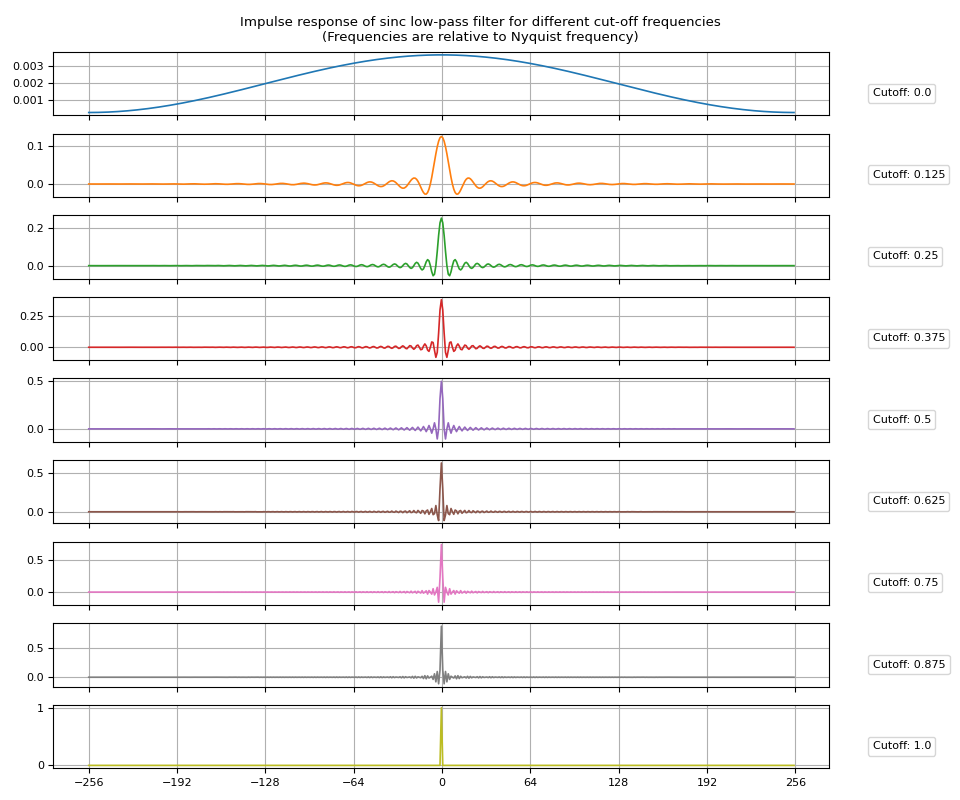
频率响应¶
接下来,我们来看一下频率响应。 Simpy 将傅里叶变换应用于脉冲响应将得到 频率响应。
frs = torch.fft.rfft(irs, n=2048, dim=1).abs()
让我们可视化生成的频率响应。
def plot_sinc_fr(frs, cutoff, band=False):
num_filts, num_fft = frs.shape
num_ticks = num_filts + 1 if band else num_filts
fig, axes = plt.subplots(num_filts, 1, sharex=True, sharey=True, figsize=(9.6, 8))
for ax, fr, coff, color in zip(axes, frs, cutoff, plt.cm.tab10.colors):
ax.grid(True)
ax.semilogy(fr, color=color, zorder=4, label=f"Cutoff: {coff}")
ax.legend(loc=(1.05, 0.2), handletextpad=0, handlelength=0).set_zorder(3)
axes[-1].set(
ylim=[None, 100],
yticks=[1e-9, 1e-6, 1e-3, 1],
xticks=torch.linspace(0, num_fft, num_ticks),
xticklabels=[f"{i/(num_ticks - 1)}" for i in range(num_ticks)],
xlabel="Frequency",
)
fig.suptitle(
"Frequency response of sinc low-pass filter for different cut-off frequencies\n"
"(Frequencies are relative to Nyquist frequency)"
)
fig.tight_layout()
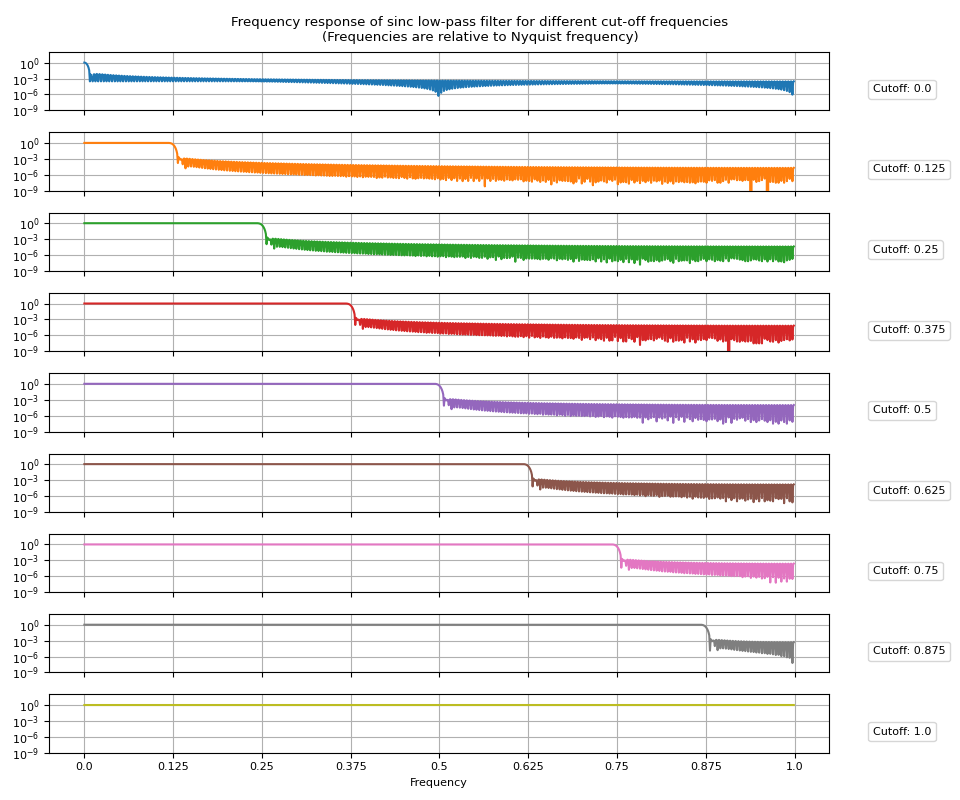
高通滤波器¶
高通滤波器可以通过减去低通来获得 来自 Dirac delta 函数的脉冲响应。
传递给high_pass=Truesinc_impulse_response()会将返回的 filter 内核更改为 high pass filter。
irs = sinc_impulse_response(cutoff, window_size=513, high_pass=True)
frs = torch.fft.rfft(irs, n=2048, dim=1).abs()
脉冲响应¶
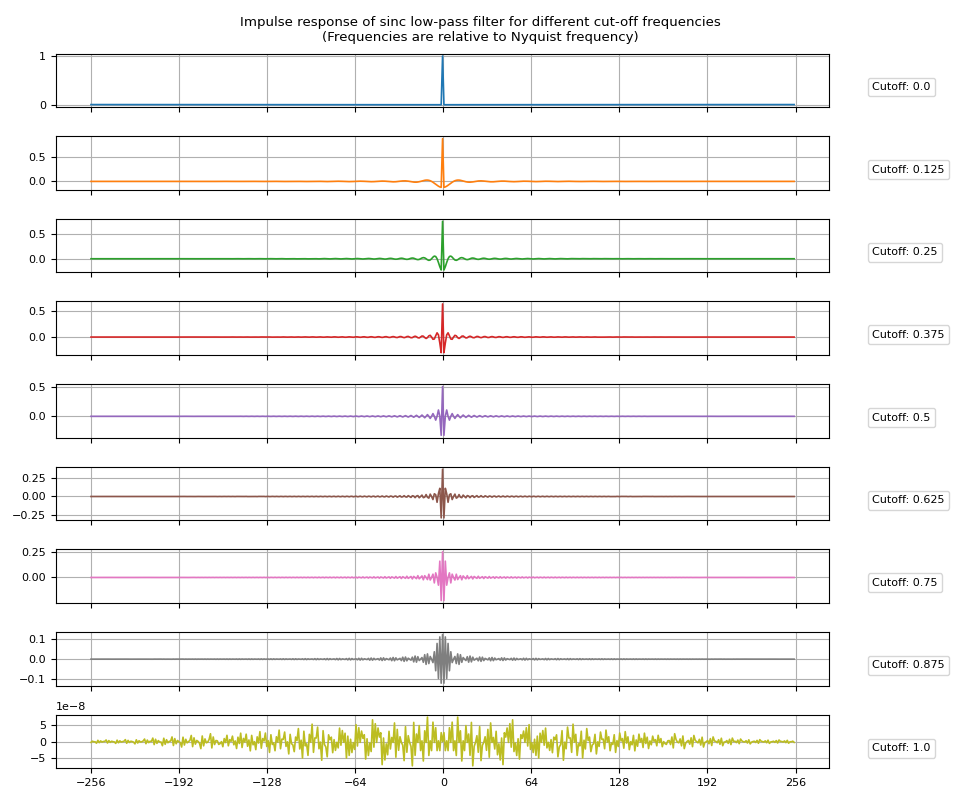
频率响应¶
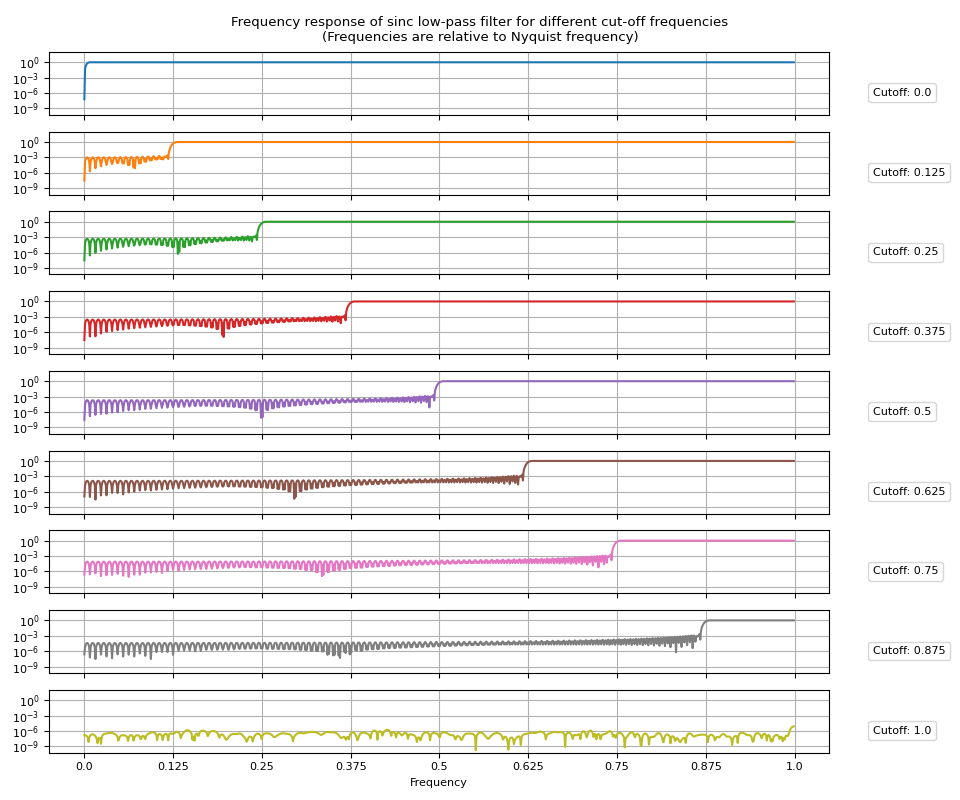
带通滤波器¶
带通滤波器可以通过减去 上带与下带的上带。
脉冲响应¶
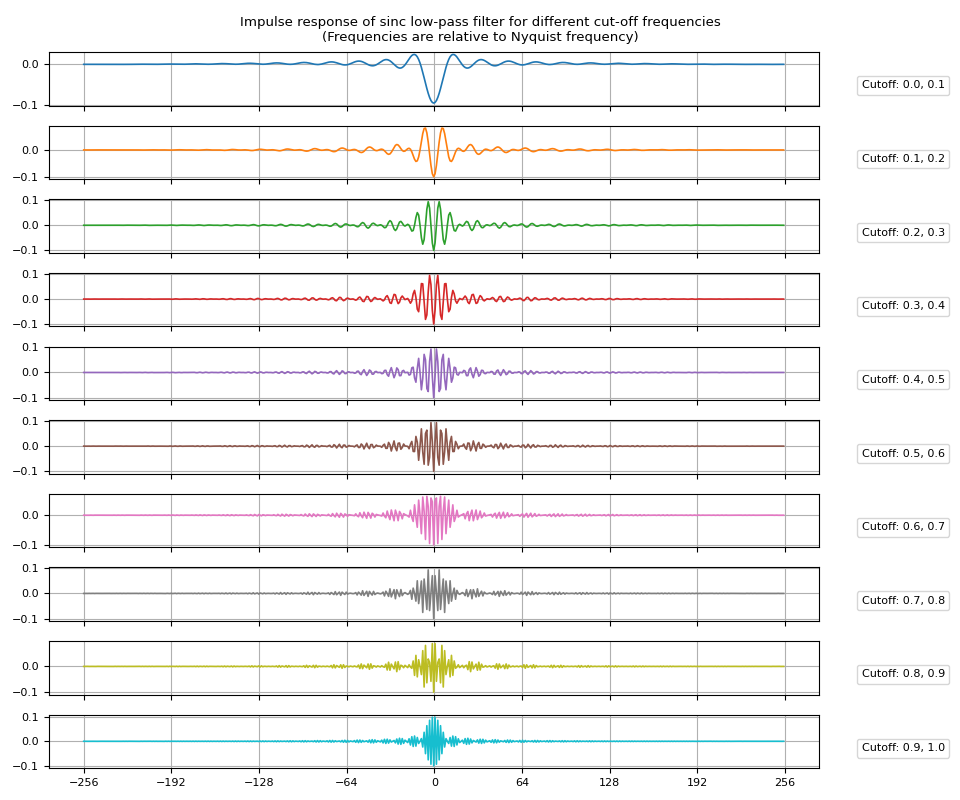
频率响应¶
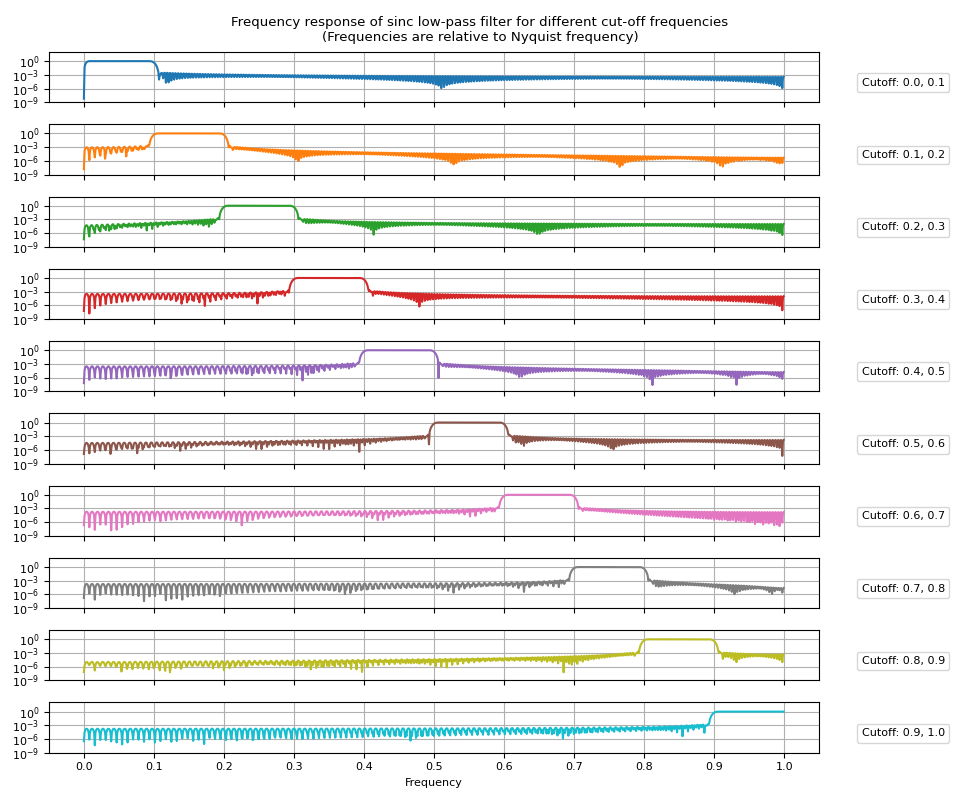
频率采样¶
我们研究的下一个方法从所需的频率响应开始 并通过应用逆傅里叶变换来获得脉冲响应。
frequency_impulse_response()取频率的 (非规范化) 幅度分布,并且
从中构造脉冲响应。
但请注意,生成的脉冲响应不会产生 所需的频率响应。
在下文中,我们将创建多个过滤器并比较输入 频率响应和实际频率响应。
砖墙过滤器¶
让我们从砖墙过滤器开始
magnitudes = torch.concat([torch.ones((128,)), torch.zeros((128,))])
ir = frequency_impulse_response(magnitudes)
print("Magnitudes:", magnitudes.shape)
print("Impulse Response:", ir.shape)
Magnitudes: torch.Size([256])
Impulse Response: torch.Size([510])
def plot_ir(magnitudes, ir, num_fft=2048):
fr = torch.fft.rfft(ir, n=num_fft, dim=0).abs()
ir_size = ir.size(-1)
half = ir_size // 2
fig, axes = plt.subplots(3, 1)
t = torch.linspace(-half, half - 1, ir_size)
axes[0].plot(t, ir)
axes[0].grid(True)
axes[0].set(title="Impulse Response")
axes[0].set_xticks([i * half // 4 for i in range(-4, 5)])
t = torch.linspace(0, 1, fr.numel())
axes[1].plot(t, fr, label="Actual")
axes[2].semilogy(t, fr, label="Actual")
t = torch.linspace(0, 1, magnitudes.numel())
for i in range(1, 3):
axes[i].plot(t, magnitudes, label="Desired (input)", linewidth=1.1, linestyle="--")
axes[i].grid(True)
axes[1].set(title="Frequency Response")
axes[2].set(title="Frequency Response (log-scale)", xlabel="Frequency")
axes[2].legend(loc="center right")
fig.tight_layout()
plot_ir(magnitudes, ir)
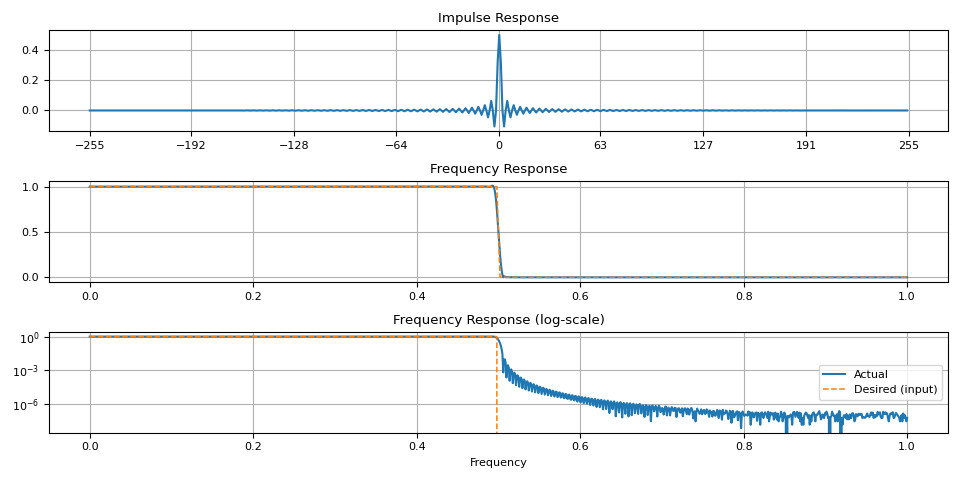
请注意,过渡带周围有伪影。这是 当窗口较小时更明显。
magnitudes = torch.concat([torch.ones((32,)), torch.zeros((32,))])
ir = frequency_impulse_response(magnitudes)
plot_ir(magnitudes, ir)
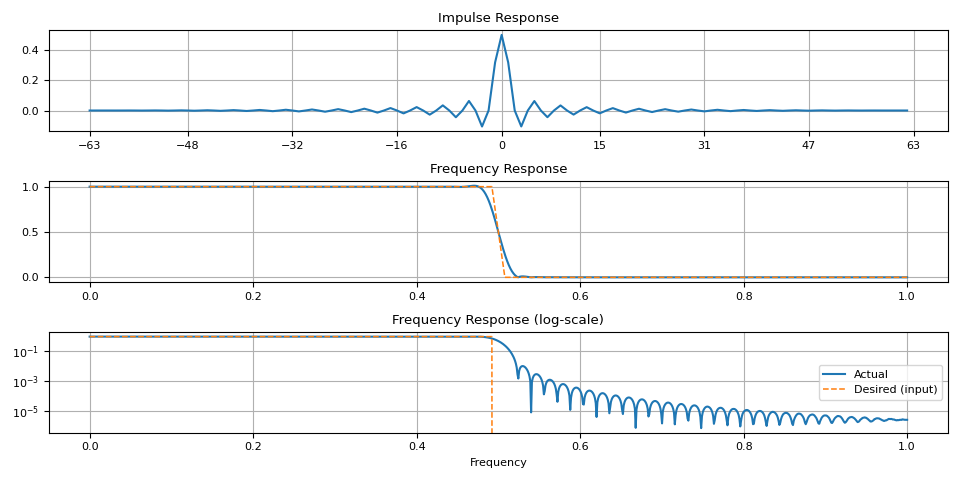
任意形状¶
magnitudes = torch.linspace(0, 1, 64) ** 4.0
ir = frequency_impulse_response(magnitudes)
plot_ir(magnitudes, ir)
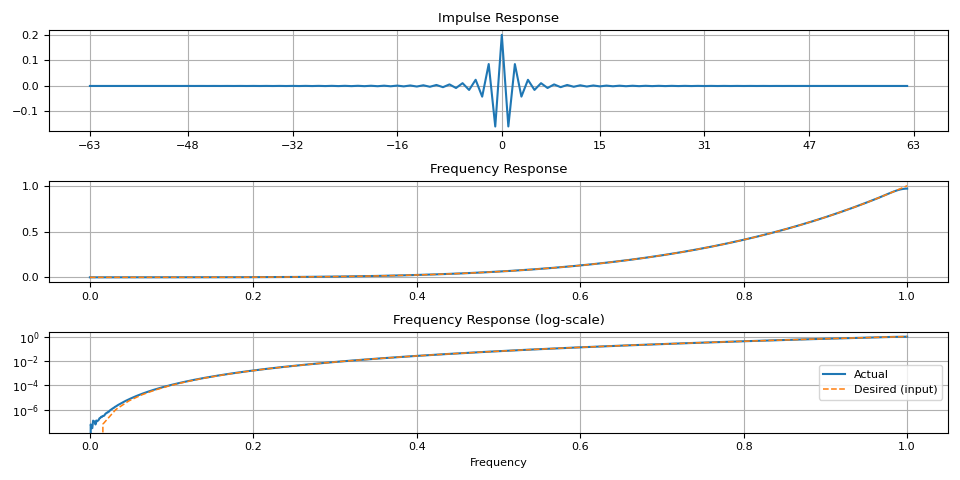
magnitudes = torch.sin(torch.linspace(0, 10, 64)) ** 4.0
ir = frequency_impulse_response(magnitudes)
plot_ir(magnitudes, ir)
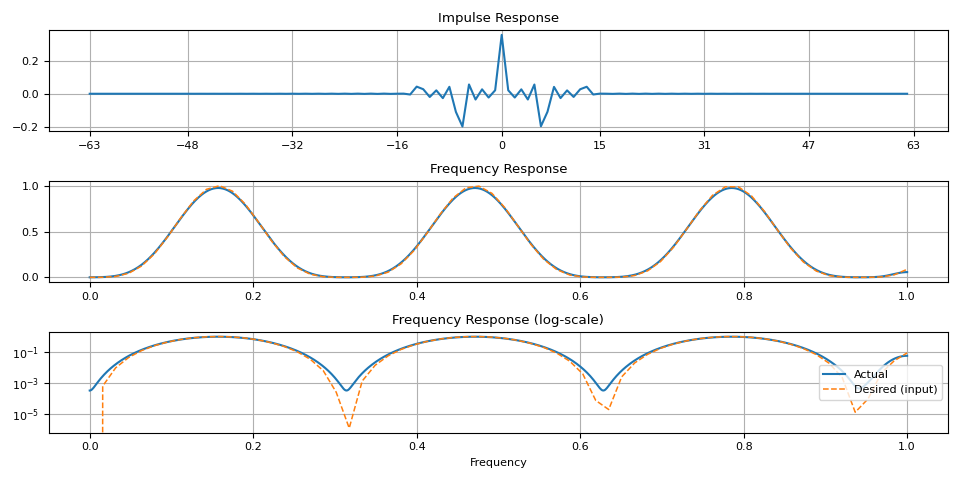
引用¶
https://www.analog.com/media/en/technical-documentation/dsp-book/dsp_book_Ch16.pdf
https://courses.engr.illinois.edu/ece401/fa2020/slides/lec10.pdf
https://ccrma.stanford.edu/~jos/sasp/Windowing_Desired_Impulse_Response.html
脚本总运行时间:(0 分 5.351 秒)